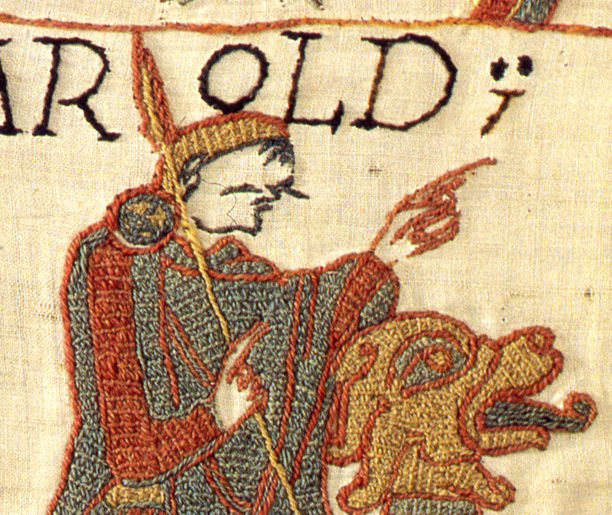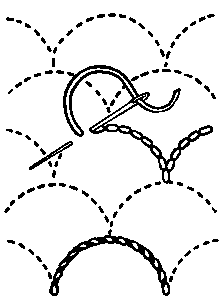Backstitch on:
[Wikipedia]
[Google]
[Amazon]

 Backstitch or ''back stitch'' and its variants ''stem stitch'', ''outline stitch'' and ''split stitch'' are a class of
Backstitch or ''back stitch'' and its variants ''stem stitch'', ''outline stitch'' and ''split stitch'' are a class of
 Backstitch is most easily worked on an even-weave fabric, where the threads can be counted to ensure regularity, and is generally executed from right to left. The stitches are worked in a 'two steps forward, one step back' fashion, along the line to be filled, as shown in the diagram.
Neatly worked in a straight line this stitch resembles chain stitching produced by a sewing machine.
The back stitch can also be used as a hand sewing utility stitch to attach two pieces of fabric together.
Backstitch is most easily worked on an even-weave fabric, where the threads can be counted to ensure regularity, and is generally executed from right to left. The stitches are worked in a 'two steps forward, one step back' fashion, along the line to be filled, as shown in the diagram.
Neatly worked in a straight line this stitch resembles chain stitching produced by a sewing machine.
The back stitch can also be used as a hand sewing utility stitch to attach two pieces of fabric together.
File:Pekinese stitch.gif, Pekinese stitch
File:Stem stitch.gif, Stem stitch
File:Whipped stem stitch.gif, Whipped stem stitch
File:Split stitch.gif, Split stitch
Sarah's Hand Embroidery Tutorials
{{sewing Embroidery stitches

 Backstitch or ''back stitch'' and its variants ''stem stitch'', ''outline stitch'' and ''split stitch'' are a class of
Backstitch or ''back stitch'' and its variants ''stem stitch'', ''outline stitch'' and ''split stitch'' are a class of embroidery
Embroidery is the craft of decorating fabric or other materials using a needle to apply thread or yarn. Embroidery may also incorporate other materials such as pearls, beads, quills, and sequins. In modern days, embroidery is usually seen ...
and sewing
Sewing is the craft of fastening or attaching objects using stitches made with a sewing needle and thread. Sewing is one of the oldest of the textile arts, arising in the Paleolithic era. Before the invention of spinning yarn or weaving ...
stitches in which individual stitches are made backward to the general direction of sewing
Sewing is the craft of fastening or attaching objects using stitches made with a sewing needle and thread. Sewing is one of the oldest of the textile arts, arising in the Paleolithic era. Before the invention of spinning yarn or weaving ...
. In embroidery, these stitches form lines and are most often used to outline shapes and to add fine detail to an embroidered picture. It is also used to embroider lettering. In hand sewing, it is a utility stitch which strongly and permanently attaches two pieces of fabric
Textile is an umbrella term that includes various fiber-based materials, including fibers, yarns, filaments, threads, different fabric types, etc. At first, the word "textiles" only referred to woven fabrics. However, weaving is not ...
. The small stitches done back-and-forth makes the back stitch the strongest stitch among the basic stitches. Hence it can be used to sew strong seams by hand, without a sewing machine.
How to do it
A versatile stitch which is easy to work, backstitch is ideal for following both simple and intricate outlines and as a foundation row for more complex embroidery stitches such as ''herringbone ladder filling stitch''. Although superficially similar to theHolbein stitch
Holbein stitch is a simple, reversible line embroidery stitch most commonly used in Blackwork embroidery and Assisi embroidery. The stitch is named after Hans Holbein the Younger (1497-1543), a 16th-century portrait painter best known for his p ...
, which is commonly used in blackwork embroidery
Blackwork, sometimes historically termed Spanish blackwork, is a form of embroidery generally worked in black thread, although other colours are also used on occasion, as in scarletwork, where the embroidery is worked in red thread. Originating ...
, backstitch differs in the way it is worked, requiring only a single journey to complete a line of stitching.
Basic backstitch is the stitch used to outline shapes in modern cross-stitch
Cross-stitch is a form of sewing and a popular form of counted-thread embroidery in which X-shaped stitches in a tiled, raster-like pattern are used to form a picture. The stitcher counts the threads on a piece of evenweave fabric (such as lin ...
, in Assisi embroidery and occasionally in blackwork
Blackwork, sometimes historically termed Spanish blackwork, is a form of embroidery generally worked in black thread, although other colours are also used on occasion, as in scarletwork, where the embroidery is worked in red thread. Originating ...
.
Stem stitch is an ancient technique; surviving mantles embroidered with stem stitch by the Paracas people of Peru
, image_flag = Flag of Peru.svg
, image_coat = Escudo nacional del Perú.svg
, other_symbol = Great Seal of the State
, other_symbol_type = National seal
, national_motto = "Firm and Happy f ...
are dated to the first century BCE. Stem stitch is used in the Bayeux Tapestry, an embroidered cloth probably dating to the later 1070s, for lettering and to outline areas filled with couching or laid-work.Levey, S. M. and D. King, ''The Victoria and Albert Museum's Textile Collection Vol. 3: Embroidery in Britain from 1200 to 1750'', Victoria and Albert Museum, 1993,
Split stitch in silk is characteristic of Opus Anglicanum
Opus Anglicanum or English work is fine needlework of Medieval England done for ecclesiastical or secular use on clothing, hangings or other textiles, often using gold and silver threads on rich velvet or linen grounds. Such English embroidery ...
, an embroidery style of Medieval England
England in the Middle Ages concerns the history of England during the medieval period, from the end of the 5th century through to the start of the Early Modern period in 1485. When England emerged from the collapse of the Roman Empire, the econ ...
.
Description of the technique
 Backstitch is most easily worked on an even-weave fabric, where the threads can be counted to ensure regularity, and is generally executed from right to left. The stitches are worked in a 'two steps forward, one step back' fashion, along the line to be filled, as shown in the diagram.
Neatly worked in a straight line this stitch resembles chain stitching produced by a sewing machine.
The back stitch can also be used as a hand sewing utility stitch to attach two pieces of fabric together.
Backstitch is most easily worked on an even-weave fabric, where the threads can be counted to ensure regularity, and is generally executed from right to left. The stitches are worked in a 'two steps forward, one step back' fashion, along the line to be filled, as shown in the diagram.
Neatly worked in a straight line this stitch resembles chain stitching produced by a sewing machine.
The back stitch can also be used as a hand sewing utility stitch to attach two pieces of fabric together.
Variants
Variants of backstitch include: *Basic backstitch or ''point de sable''. *Threaded backstitch *Pekinese stitch, a looped interlaced backstitch *Stem stitch, in which each stitch overlaps the previous stitch to one side, forming a twisted line of stitching, with the thread passing below the needle. It is generally used for outlining shapes and for stitching flower stemsReader's Digest ''Complete Guide to Needlework''. The Reader's Digest Association, Inc. (March 1992). , p. 48 and tendrils. *Whipped back stitch using thread of a different color than the original stitch, the needle is passed under the stitch without piercing the fabric, repeated to created a colorful twisted effect *Outline stitch, sometimes distinguished from stem stitch in that the thread passes above rather than below the needle. *Split stitch, in which the needle pierces the thread rather than returning to one side. *Ringed back stitch, back stitches are worked to create half rings, these are completed by a second row of stitches to form ring outlinesStitch gallery
See also
* Assisi embroidery *Blackwork embroidery
Blackwork, sometimes historically termed Spanish blackwork, is a form of embroidery generally worked in black thread, although other colours are also used on occasion, as in scarletwork, where the embroidery is worked in red thread. Originating ...
* Cross-stitch
Cross-stitch is a form of sewing and a popular form of counted-thread embroidery in which X-shaped stitches in a tiled, raster-like pattern are used to form a picture. The stitcher counts the threads on a piece of evenweave fabric (such as lin ...
* Embroidery stitch
In everyday language, a stitch in the context of embroidery or hand- sewing is defined as the movement of the embroidery needle from the back of the fibre to the front side and back to the back side. The thread stroke on the front side produced ...
esNotes
References
*Caulfield, S.F.A., and B.C. Saward, ''The Dictionary of Needlework'', 1885. *Eaton, Jan. ''Mary Thomas's Dictionary of Embroidery Stitches'', Revised by Jan Eaton. London: Hodder&Stoughton, 1989. *Enthoven, Jacqueline: ''The Creative Stitches of Embroidery'', Van Norstrand Rheinhold, 1964, *Reader's Digest, ''Complete Guide to Needlework''. The Reader's Digest Association, Inc. (March 1992). *Levey, S. M. and D. King, ''The Victoria and Albert Museum's Textile Collection Vol. 3: Embroidery in Britain from 1200 to 1750'', Victoria and Albert Museum, 1993,Sarah's Hand Embroidery Tutorials
{{sewing Embroidery stitches